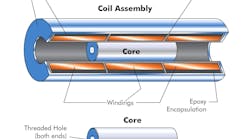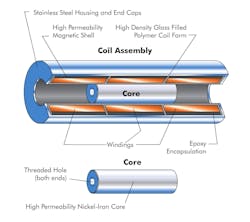The following five terms and parameters often cause the most confusion when choosing an LVDT.
Nominal Linear Range: The primary variable engineers look at when choosing linear variable differential transformers (LVDT) is the maximum range of core motion, which produces an analog output of specific linearity. Full-scale displacement is the distance a core can travel from its null position in this linear region. Because the core can be displaced from null toward either end, the linear operating range is twice the full-scale displacement. When stated as plus or minus (+/-), full-scale displacement is referred to as the nominal linear range. When stated without a polarity, it is called the LVDT's full range, full stroke, or total stroke.
The nominal linear range of any LVDT varies with frequency. When the LVDT is used with the correct core for the specified frequency, the actual linear range will always equal or exceed the nominal value. When optimum linearity is not essential in an application, the practical operating range may extend well beyond the specified nominal linear range. Nominal linear range is specified for a high impedance load, typically 50k to 0.5M Ohms. Low-load impedances can degrade linearity and reduce the nominal linear range.
Linearity error: The output of an LVDT is a nominally linear function of core displacement within its linear range of motion. This means a plot of output voltage magnitude versus core displacement is essentially a straight line. Beyond the nominal linear range, however, output begins to deviate from a straight line into a gentle curve. From a statistically best-fit straight line versus core displacement within an LVDT's nominal linear range, the maximum deviation of LVDT output is defined as the linearity error or the non-linearity of the LVDT.
Linearity error is typically expressed as +/- a percentage of full-range output or in terms of an error band that includes the straight line and deviations. The proper interpretation of linearity error for an LVDT depends on the ultimate application of the LVDT in a measurement application. Some engineers use non-linearity as a measure of system accuracy as it is often the largest error.
Full-scale output: For an AC-LVDT, full-scale output is the output of an LVDT with its core positioned at full-scale displacement and with its primary excited at a specified nominal input voltage. In most cases, though, a better way to compare AC-LVDTs of the same linear range is through sensitivity. Sensitivity is usually specified in terms of millivolt output per thousandths of an inch core displacement per Volt of excitation (mV/mil/Volt). Sensitivity varies with excitation frequency, which must also be specified. Sensitivity mostly affects the gain required of the LVDT's signal conditioning electronics.
For most DC-LVDTs, the characteristic comparable to sensitivity is scale factor, which is usually expressed as Volts DC output per inch of core displacement. Some legacy DC-LVDTs use a ratiometric configuration, which requires they also use the same units as sensitivity, or have their scale factor specified for a particular DC input voltage. There are also DC-LVDTs whose output goes into a 4-20mA current loop, so their scale factors are expressed as milliamperes per inch (mA/in) or milliamperes per mil (mA/mil).
Resolution: Resolution is the change in smallest core position change that detected in the LVDT’s output. An LVDT's resolution is essentially infinite as it operates on the principle of magnetic coupling. An infinitesimal change in core position produces a change in the output. In practice, the limitation on system resolution is determined by the ability of the associated electronic equipment to sense the change in LVDT output, which is called the signal-to-noise ratio of the system. With a properly designed LVDT measuring system, microinch resolutions are not uncommon.
Repeatability: The ability of a sensor to reproduce the same output given the same input under the same constant operating and environmental conditions is the single most important factor for sensor selection. This parameter, called repeatability, is the only irreducible and uncorrectable source of static error in any electromechanical measuring system. Repeatability error is the limiting factor in making any sensor-based measurement.
A well-made LVDT is so repeatable that it is affected only by the mechanical factors of the physical members or structures to which the LVDT's core is attached and to which the LVDT's coil is mounted. Both repeatability and resolution contribute to overall measurement error, and are usually expressed as a percentage of full-scale output. These parameters apply equally well to AC-LVDTs and DC-LVDTs.
Eileen Otto is the Marketing Manager at Macro Sensors in Pennsauken, N.J.

